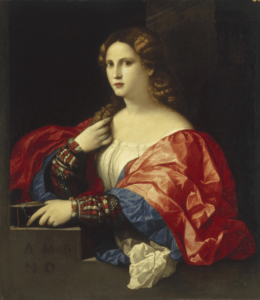
Portrait of a woman, by Palma Vecchio (presumed to be Francesca Caccini).
Francesca Caccini was born on September 18, 1587 in Florence to Giulio Caccini, a successful Florentine musician. Her childhood was spent under her father’s musical tutelage, where she had the chance to showcase her talents in roles her father had written for the stage. Early in her career, Francesca attempted to gain recognition for her own musical talents outside of Florence, but found that her mild success was not comparable to the possibilities that a Medici patronage offered. Her father had long been a featured artist for the Medici family (who had ruled over Florence for some two hundred years); they were well known for their support of the arts. His contacts gave his daughter a way to get into the male-dominated Italian musical world in 1607. Despite her marriage to Giovanni Battista Signorini in November of the same year, Francesca sought to make her music known in a period which denied women that sort of public acclaim.
Once she was commissioned by the Medici family, her musical virtuosity gained her great fame. While working on opera compositions and practicing the four instruments she knew how to play, Francesca taught young female courtiers how to sing and play. However, her artistic talents stretched beyond the musical realm. Evidence that she also had a talent for the written word was found in the poetry that she wrote – in both Italian and Latin. It has been thought that some of these poems could have been lyrics written to accompany her compositions and shows how devoted Francesca was to her craft. Her artistic fervor did not subside with the births of her two children. Margherita was born in 1622 during her marriage to Signorini, and Tommaso was born in 1628 to her second husband, Tommaso Raffaeli. Following her second child’s birth, Francesca traveled throughout Europe to play for other European royalty, always returning home to the Medici court.
Perhaps her most important historical contribution was her ability to secure her legacy by having her musical compositions published. In a period of time where society disapproved of women seeking public fulfillment out of traditionally male occupations, this was impressive. Francesca fought against these constraints to fill the world with music, and stood as an example that women could handle both motherhood and a profession. Recordings of her operas can be found across the internet and in hard copies across the globe. The oldest of her known compositions was written in 1625 (La liberazione di Ruggiero dall’isola d’Alcina, or The Liberation of Ruggiero from Alcina’s Island) and is considered by many to be the oldest opera written by a woman. Unfortunately, most physical copies of Francesca’s work did not survive past the Renaissance period, but those that did so remain beloved by opera goers and musical lovers alike.
